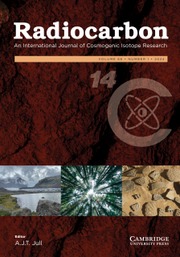No CrossRef data available.
Article contents
SOURCE APPORTIONMENT OF ATMOSPHERIC AND SEDIMENTARY PAHS FROM KOLKATA, INDIA USING COMPOUND-CLASS-SPECIFIC RADIOCARBON ANALYSIS (CCSRA)
Published online by Cambridge University Press: 18 September 2024
Abstract
Polycyclic aromatic hydrocarbons (PAHs) are major air pollutants that are ubiquitously produced by the combustion of organic materials, and it is extremely important to identify their pollution sources. In this study, molecular fingerprinting and compound class-specific radiocarbon dating (CCSRA) were performed on PAHs from canal sediments and air samples collected in Kolkata, India’s third largest city (population approximately 16 million), where PAHs pollution has been a serious problem. Average PAH (Σ12-parent PAHs) concentrations in air samples were 65.1 ng m–3 in summer and 70.9 ng m–3 in winter and in canal sediments were 32.7 µg g–1, which are classified as “very high-level” pollution. Molecular fingerprinting using methyl-PAH/PAH (MPAHs/PAHs) ratios and isomer pair ratios with molecular weights of 178, 202, 228, and 276 suggested that wood and coal combustion were the dominant sources of PAHs in the sediment, and that atmospheric PAHs were influenced by oil combustion in addition to them. The fraction of contemporary carbon (ƒC) of sedimentary PAHs (0.056–0.100), together with the extremely low MPAHs/PAHs ratio results, lead to the conclusion that the major source of the high concentration of PAHs in the canals is from coal combustion. On the other hand, the ƒC of atmospheric PAHs (0.272–0.369) was close to the share of biomass fuels in India’s domestic fuel consumption in 2011 (about 35%). Furthermore, the observed ƒC-discrepancy between atmospheric and sedimentary PAHs in the same urban environment was interpreted to give an insight into the loading pathway of PAHs to canal sediments in Kolkata.
Keywords
- Type
- Conference Paper
- Information
- Radiocarbon , Volume 66 , Issue 5: 24th Radiocarbon and 10th 14C & Archaeology, Zurich, Sept. 11–16, 2022 Proceedings Part 1 of 2 , October 2024 , pp. 892 - 903
- Copyright
- © The Author(s), 2024. Published by Cambridge University Press on behalf of University of Arizona
Footnotes
Selected Papers from the 24th Radiocarbon and 10th Radiocarbon & Archaeology International Conferences, Zurich, Switzerland, 11–16 Sept. 2022.



